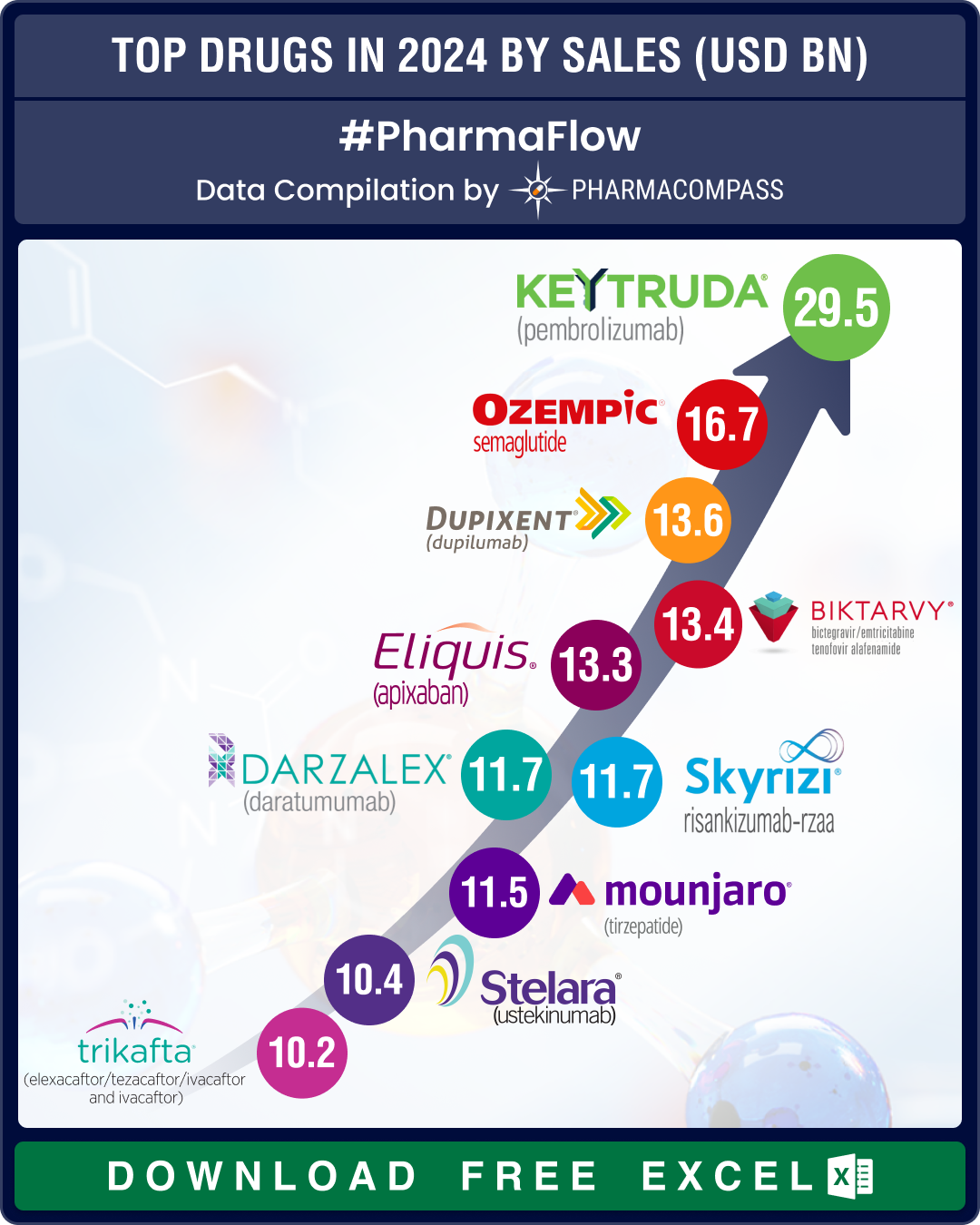By PharmaCompass
2022-09-01
Impressions: 4203
Swiss-drug major Novartis has been trying to reinvent itself for nearly a decade, a process that was started by its erstwhile CEO Joseph Jimenez, who passed the baton to Vasant Narasimhan in February 2019, along with the same mandate.
Over the last eight years, Novartis has exited businesses (like animal health, vaccines and consumer health), spun off its eye care devices business, acquired companies and products and narrowed down its focus. It’s now getting ready to spin off its generic business — Sandoz. It has also confirmed that it will lay off over 7 percent of its workforce to become more profitable. With these measures, the company hopes to post consistent growth up to 2030 and beyond.
In the first article of our Company Tracker series, we summarize Novartis’ strategy and growth story.
View our Dashboard to know more about Novartis' Drugs and Developments (Free Excel)
Transforming into a focused medicines company
Prior to 2014, Novartis was a diversified healthcare group with interests in animal health, vaccines and consumer health products, besides pharmaceuticals. In April 2014, Eli Lilly announced an agreement to acquire Novartis’ animal health business for approximately US$ 5.4 billion. In March 2015, Novartis acquired certain oncology products and pipeline compounds from GSK for US$ 16 billion. In return, GSK acquired Novartis’ global vaccines business (excluding influenza vaccines) for an initial cash consideration of US$ 5.25 billion.
In 2018, GSK also bought out Novartis’ 36.5 percent stake in their consumer healthcare joint venture for US$ 13 billion (£9.2 billion). The JV had been formed in 2014.
The following year, Novartis spun off its eye care devices business Alcon. Last year, it sold its 33 percent stake in Roche for US$ 20.7 billion. And in April this year, Novartis said it is merging pharmaceuticals and oncology into an Innovative Medicines (IM) unit.
With these measures, Novartis says it is now a “focused medicines company” and has been successful at delivering consistent performance.
Today, Novartis has presence in five core therapeutic areas – hematology, solid tumors, immunology, neuroscience and cardiovascular-renal – and strength in technology platforms such as gene therapy, cell therapy, radioligand therapy, targeted protein degradation and xRNA.
Novartis has two divisions — Sandoz (a generic pharmaceuticals and biosimilars company) and Innovative Medicines (IM), which is made up of two separate commercial organizations — Innovative Medicines International and Innovative Medicines US.
The Swiss pharma giant has two companies — (a) Advanced Accelerator Applications or AAA (focused on radioligand therapy and precision imaging) and (b) Gyroscope Therapeutics, a company that Novartis acquired last year. Gyroscope is a clinical-stage gene therapy company that focuses on eye diseases.
It posted group sales of US$ 51.6 billion in 2021, a growth of 4 percent over its 2020 sales. The net sales of the IM business grew by 6 percent (over the previous year) to US$ 42 billion in 2021. During the same period, the net sales of Sandoz dropped by 2 percent to US$ 9.6 billion. As on August 31, Novartis had a market cap of CHF 172.72 billion (US$ 176.17 billion). Novartis trades with the ticker symbol "NOVN" on the SIX Swiss Exchange.
View our Dashboard to know more about Novartis' Drugs and Developments (Free Excel)
Embarking on further reorganization
Ever since he took charge, Narasimhan has been trying to convince the shareholders that he can improve the drug behemoth’s performance. He has chalked out a reorganization plan to save a billion dollars-plus in various costs by 2024 in order to make Novartis more profitable.
In June, the company had announced it will cut as many as 8,000 of its 108,000 staff, or about 7.4 percent of its global workforce, in a bid to make the organization “leaner and simpler” and save around US$ 1 billion in costs.
Novartis had kicked off a strategic review of Sandoz in October last year. Like Alcon, Novartis has decided to spin off its generics division into a publicly traded, standalone business by 2023. This will make Sandoz Europe’s largest generics company. In H1 2022, Sandoz generated sales of US$ 4.7 billion (a growth of 6 percent over H1 2021).
Last week, the drugmaker announced plans to shutter its Sandoz oral solid dosage plant in Wilson, North Carolina, by the end of 2023. The plant makes tablets and capsules for Canada and the US. Around 246 employees working at the site have already been informed about the closure. Alongside this manufacturing site, Novartis is also closing additional office space in Durham, North Carolina.
With all these measures, Novartis hopes to grow at over 4 percent per annum until 2026. Post that, Novartis hopes to double-down on its internal pipeline to unlock the full potential of these assets. Beyond 2030, Novartis plans to make focused investments in technology platforms while staying at the forefront of innovation in small and large molecules.
View our Dashboard to know more about Novartis' Drugs and Developments (Free Excel)
Five strong performing drugs bring in healthy topline growth
In the first half of 2022, net sales of Novartis grew at a healthy rate of 5 percent to US$ 25.3 billion. Its IM unit grew by 5 percent (over H1 2021) to US$ 20.6 billion. Sales growth was mainly driven by continued strong performance of its five drugs – Entresto (growth of 37 percent), Kesimpta (280 percent), Cosentyx (12 percent), Kisqali (36 percent), Zolgensma (22 percent) - newly launched drug Leqvio. In the US, sales were mainly driven by Entresto and Kesimpta.
Cosentyx (secukinumab), a monoclonal antibody, is approved for psoriasis, psoriatic arthritis and axial spondyloarthritis. In June, it received expanded approvals in the EU for use in childhood arthritic conditions. The half-yearly sales of Cosentyx stood at US$ 2.4 billion, and peak sale is estimated at around US$ 7 billion.
Novartis is developing Cosentyx for over 10 indications. This year, Novartis has submitted an application in the EU for the use of the drug to treat hidradenitis suppurativa (HS), a painful, long-term skin condition that causes abscesses and scarring on the skin. The drugmaker has planned US submission for HS in H2 2022.
Heart failure prescription medicine Entresto (sacubitril/valsartan) posted H1 sales of US$ 2.2 billion. Novartis is conducting a phase 3 trial for the use of Entresto in congestive heart failure in children, and plans to submit an application for supplementary approval in Europe this year. Entresto is estimated to bring in over US$ 5 billion per annum during 2025 to 2036.
Novartis’ gene therapy for the treatment of spinal muscular atrophy (SMA) — Zolgensma (onasemnogene abeparvovec) — posted H1 sales of US$ 0.7 billion. Recently, Zolgensma was in the news for the death of two children due to acute liver failure. Post that, Novartis has requested the FDA for a label update. Zolgensma is expected to bring in over US$ 2 billion during 2025 to 2036.
Kesimpta (ofatumumab), a treatment for relapsing forms of multiple sclerosis (MS) in adults, brought in sales of US$ 434 million during H1. The company is holding a phase 3 trial for the use of Kesimpta to treat MS in pediatrics. The drug is expected to bring in US$ 3.3 billion in peak sales by 2028.
Breast cancer drug Kisqali (ribociclib) generated sales of US$ 547 million in H1 2022. It is a kinase inhibitor with the longest median overall survival in postmenopausal HR+/HER2- metastatic breast cancer patients. Kisqali is expected to bring in over US$ 2 billion in peak sales.
View our Dashboard to know more about Novartis' Drugs and Developments (Free Excel)
Betting on new CAR-T platform, pipeline with over 150 projects
Novartis has a robust pipeline. It has more than 150 projects in clinical development, with 42 projects in oncology (solid tumor), 33 in immunology, 26 in hematology, 12 in cardiovascular-renal, 11 in neuroscience, 25 in ophthalmology, respiratory and allergy as well as and two biosimilar projects. There are around 49 projects in phase 3 and 98 in the early and middle stages of development.
Moreover, four Novartis projects are awaiting regulatory approvals. The company expects over 20 plus potential billion US$ pipeline assets to be approved by 2026, which would fuel growth through 2030 and beyond.
Novartis has 30 new molecular entities (NMEs) in the global clinical pipeline. For instance, JDQ443 (KRAS G12C inhibitor), which is currently in phase 3, demonstrated anti-tumor activity with acceptable safety in non-small cell lung cancer (NSCLC). Once approved, the drug will certainly put pressure on products like Mirati’s KRAS inhibitor — adagrasib — and Amgen’s Lumakras.
Other important pipeline products are iptacopan (IgA nephropathy and paroxysmal nocturnal haemoglobinuria, in phase 3); pelacarsen (cardiovascular disease and lipoprotein, in phase 3); remibrutinib (MS and chronic spontaneous urticaria, in phase 3); ociperlimab in combination with tislelizumab (for NSCLC, in phase 3); branaplam (Huntington’s disease, in phase 2); sabatolimab (myelodysplastic syndromes, in phase 3) and icenticaftor (chronic obstructive pulmonary disease, in phase 2).
Novartis is also working on a next-generation CAR-T platform — T-Charge — that “preserves the T cell stemness,” or the ability of T cells to self-renew and mature. The unique characteristics of the T-Charge platform may lead to improved patient outcomes with reduced risk of severe adverse events. Several CAR-T therapies are being developed using this platform, such as YTB323 (anti-CD19 CAR-T), currently in phase 3 for the treatment of diffuse large B-cell lymphoma, and PHE885 (anti-BCMA CAR-T), currently in phase 2 for the treatment of multiple myeloma.
View our Dashboard to know more about Novartis' Drugs and Developments (Free Excel)
Forging deals with BeiGene, Gyroscope, Alnylam
In 2021, Novartis was among the busiest pharma dealmakers, as it used up funds raised from the Roche stake sale. It signed two significant deals with Chinese biotech BeiGene worth US$ 2.2 billion to develop and commercialize anti-PD-1 antibody tislelizumab.
In a follow-up deal, signed in December 2021, Novartis signed a collaboration and license agreement worth US$ 2.9 billion for the late-stage TIGIT inhibitor ociperlimab, which is in phase 3 development for advanced NSCLC in combination with tislelizumab. As part of the deal, BeiGene was granted rights to market, promote and detail five approved Novartis oncology products – Tafinlar (dabrafenib), Mekinist (trametinib), Votrient (pazopanib), Afinitor (everolimus) and Zykadia (ceritinib) across designated regions of China.
In December 2021, Novartis entered into a potential US$ 1.5 billion agreement to acquire Gyroscope Therapeutics, a company that focuses on the discovery and development of gene therapy treatments for retinal indications. The acquisition closed on February 17, 2022.
In March this year, Novartis announced a US$ 1.75 billion license option agreement with Voyager Therapeutics for next-generation gene therapy vectors for neurological diseases.
In December 2021, Novartis received FDA approval for Leqvio (inclisiran), the only FDA-approved small interfering RNA (siRNA) therapy for LDL-C (bad cholesterol) reduction. Novartis had obtained global rights to develop, manufacture and commercialize Leqvio under a license and collaboration agreement with Alnylam Pharmaceuticals. The two companies announced a collaboration the following month to leverage Alnylam’s proven, proprietary siRNA technology to develop a treatment designed to promote the regrowth of functional liver cells and to provide an alternative to transplantation for patients with end-stage liver disease.
View our Dashboard to know more about Novartis' Drugs and Developments (Free Excel)
Vijoice, Tafinlar-Mekinist combo bag FDA accelerated approvals; Kymriah gets add-on nod
In March this year, Novartis’ Pluvicto got approved by the FDA for the treatment of patients with a type of advanced prostate cancer that has spread to other parts of the body. Pluvicto is a targeted radioligand therapy for adult patients who have already undergone other anti-cancer treatments. The company had acquired the therapy in 2018, as part of its US$ 2.1 billion purchase of Endocyte. However, in May, Novartis had to temporarily suspend the production of two of its cancer drugs – Lutathera and Pluvicto – due to potential quality issues found in the manufacturing process at its facilities in Ivrea (Italy) and Millburn, New Jersey. Both drugs are radiopharmaceuticals.
In June, the company restarted production of Pluvicto and Lutathera at both the plants. Novartis has predicted sales of US$ 2 billion from Pluvicto.
In April, Vijoice (alpelisib) received accelerated approval for adult and pediatric patients (two years of age and older) with severe manifestations of PIK3CA-related overgrowth spectrum (PROS), a rare disease. Vijoice is the only FDA approved treatment to specifically address the root cause of PROS conditions.
In June, Novartis’ Tafinlar-Mekinist drug combination received an accelerated approval from the FDA to treat any metastatic solid tumor with a mutation known as BRAF V600.
In March, Beovu (brolucizumab) was approved in the EU for the treatment of diabetic macular edema (DME). And in June, the FDA also approved it. It is already approved in wet age-related macular degeneration (AMD).
Novartis’ Kymriah (tisagenlecleucel), which was originally approved five years back, has attained an add-on approval as a treatment for adults with relapsed or refractory follicular lymphoma, pitching it as a rival to Gilead Sciences' Yescarta. This is the third FDA approval for Kymriah, which is the only CAR-T cell therapy allowed for use in both pediatric and adult patients. The US nod for Kymriah comes weeks after the EU authorized it for the same indication.
View our Dashboard to know more about Novartis' Drugs and Developments (Free Excel)
Our view
Under Narasimhan, Novartis has invested in several new drug-making technologies. It may not have hit a jackpot like Pfizer and Moderna, but it has been quietly restructuring itself during the pandemic. The Swiss drugmaker’s robust pipeline and its focus on new technology platforms in the areas of cell and gene therapy and radiopharmaceuticals hold a lot of promise. We also see more growth in IM sales in the coming years.
Novartis appears confident of delivering sales growth of around 4 percent per annum or more until 2026. Alongside, it is also working on improving its profitability by reducing costs and spinning off its generic business (Sandoz). While these targets seem reasonable, a lot will depend on how many of its pipeline drugs end up bagging approvals in the coming years. Its future depends on its pipeline and the technologies it is betting on.
(All financial and drug pipeline-related information has been taken from the Novartis website.)
The PharmaCompass Newsletter – Sign Up, Stay Ahead
Feedback, help us to improve. Click here
Image Credit : Company Tracker by PharmaCompass license under CC BY 2.0
“ The article is based on the information available in public and which the author believes to be true. The author is not disseminating any information, which the author believes or knows, is confidential or in conflict with the privacy of any person. The views expressed or information supplied through this article is mere opinion and observation of the author. The author does not intend to defame, insult or, cause loss or damage to anyone, in any manner, through this article.”








